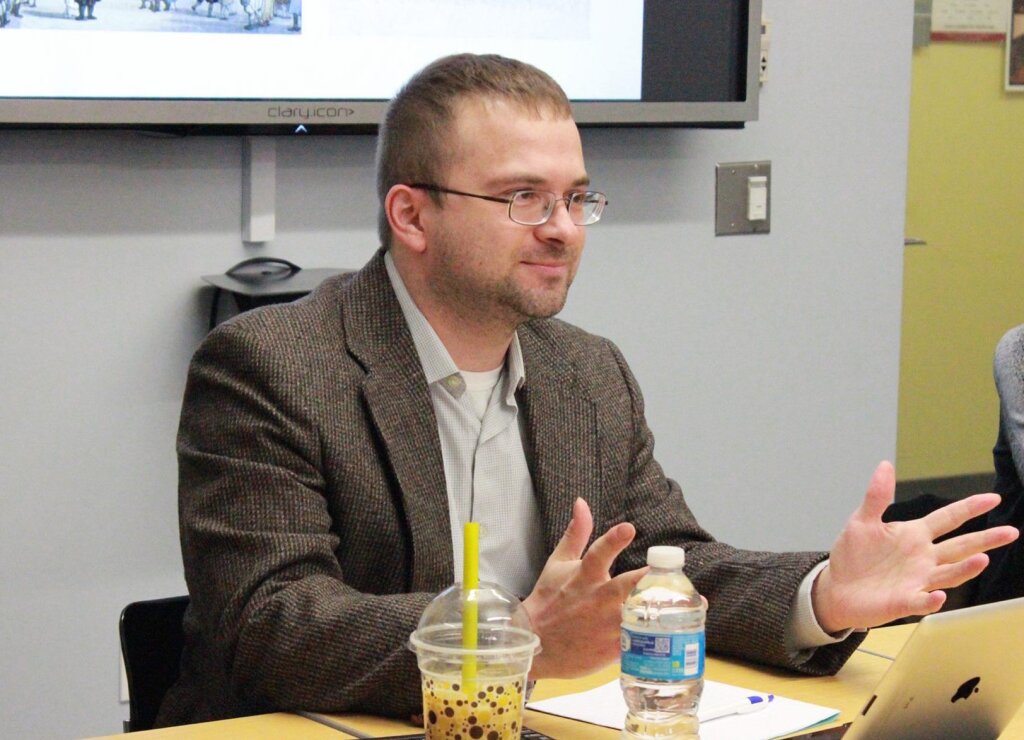Watch the video of the event here
On March 6, 2015, the Jordan Center welcomed Kristy Ironside, a Postdoctoral Fellow at the Higher School of Economics in Moscow, to speak about the Soviet tax on bachelors, singles persons and small families that was decreed by Nikita Khrushchev at the beginning of the Great Patriotic War in 1941. The event, titled “Between Postwar Fiscal and Social Dilemmas: The Tax on Bachelors, Single Persons and Citizens with Small Families of the USSR, 1941-1961," was largely discussion-based, and covered subjects such as normative and didactic dimension of taxes in the USSR, the concept of money in a socialist system, as well as the friction between ideology and implementation of financial policies. Ironside’s paper – which was circulated prior to the event – is a segment of a larger book project, focusing on the Soviet post-war economic history. She is particularly interested in the ways in which money was used to rebuild and develop a prosperous economy after the devastating effects of the war.
The tax on bachelors, single persons, and small families targeted any person or family with fewer than three children. It was an economic tactic designed to boost the Soviet post-war declining demographic rates and generate funds to rebuild the country. Ironside pointed out that the tax remained highly problematic because “there was a schism between how Khrushchev talked about it, how people spoke about it, and how the Ministry of Finances understood it.”
For Khrushchev, the tax seemed to be about a particular vision of a family unit and a quantitative approach to reproduction. “I think on some level Khrushchev really did think people should go ahead and have these children,” Ironisde asserted. It was all about the numbers, she added, and he did not care if large numbers of these children would end up in orphanages.
Understandably, the tax was met with a lot of resistance in the post-war era, especially by people with lower incomes (in particular, peasants on the countryside): the country was in shambles and thousands of people faced poverty and famine. The tax provoked a lot of anger. According to Ironside’s archival research, the Ministry of Finances received endless amount of letters expressing outrage against this tax, in an increasingly cruder language as time went by. Many people simply refused to pay the tax, but very rarely they would be severely punished.
Nevertheless, the Ministry of Finances spent a lot of money to monitor and control those who refused to pay. The officials working at the Ministry of Finances, who received the numerous complaints and faced people’s refusal to comply with the tax, understood that it somehow failed on an ideological dimension. However, it was not the Ministry’s job to deal with the ideological concerns. While it troubled many officials that the tax was incoherent, in the end of the day, they were “only responsible for reporting a balanced budget.”
Despite the evident failure of the tax, Ironiside remarked, she does not want to focus purely on its failure, as it is too easy to write on the subject of failure in Soviet history. Instead, she wants to flash out how the officials were trying to make use of the money. For instance, the Soviets saw a direct correlation between birthrate and prosperity and assumed that the more money they were able to redistribute to families, the more children the families would have.
As the discussion showed, the various elements of the tax and the ways that people handled it reveals a unique attitude towards money in the Soviet Union. For instance, the revenue of the tax was meant to go back into the national economy, to allow for more goods to be produced, and to ensure that people had more money to spend on goods. Therefore, the financial model in the Soviet Union was distinct from capitalism because it rested more on balance rather than profit. “What comes in must come out,” Yanni Kotsonis remarked. Anne Lounsbery noted that it is interesting that in a socialist economy, where people are uncomfortable with the idea of money, there is nevertheless so much cash circulating.
The discussion also addressed other dimensions of the tax that reached beyond financial benefit. For instance, as the tax was implemented in a state of emergency, it carried a strong punitive dimension. As Yanni Kotsonis observed, in the Soviet context the punitive measures were always about establishing norms and dictating to the society what it should be. While the tax itself failed in generating profit, it was perhaps more important as a tool to teach society a political lesson of family norms and reproduction. Therefore, didacticism, not profit, was arguably the goal of the economic policy.
The discussion ended with several recommendations and suggestion to Ironside on her project.



